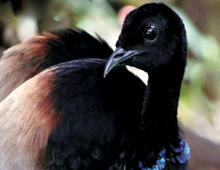Description: A ground-dwelling bird, Grey- winged trumpeters, have a chicken-like appearance with their long neck, long legs, hump back and their short, sharp and slightly decurved bill. Their velvety plumage is predominantly black, except for the rump, lower back and inner wings which are light gray. The lower neck is an iridescent purplish- blue and the feet are bluish gray. They have large, dark brown eyes and a short tail. Juveniles are dark gray with streaks and bars of cinnamon and rufous.
Size: They reach a total length of 19-20 inches (48-56cm) and a weight of two to three pounds (1-1.3 kg).
Behavior: They are gregarious birds and during the non-mating season their flocks are large. Even though they are capable of flight, they spend most of their day foraging for food on the forest floor. They are infrequent and weak fliers, but at night, they perch in trees to sleep.
Diet: Since they prefer to walk instead of flying, their diet consists of insects and fruit that has dropped to the ground.
Communication: They are named for their, loud complex vocalizations, which sometimes sound if they are producing several sounds at the same time. This trumpeter has calls with six to eight low humming notes. They also have a
loud “jeek” or honking “tzaak” call. When threatened or alarmed they produce grunts.
Reproduction: Breeding seems to occur during the peak fruiting season within their range. When mating, they perform elaborate and noisy courtship displays. They leap and strut around with their wings spread wide following or circling one another. A dominant female will mate with up to three dominate males and then lay three to six white eggs in the nest (a hollow in a tree). The eggs are incubated for about 28 days by all adult members of the small group.
Habitat/range: These South American birds inhabit undisturbed dense rainforests, especially those rich with fruiting trees, north of the Amazon River from southeastern Colombia, through eastern Ecuador, to northern Peru, east through northern Brazil, southern and eastern Venezuela and Guyana.
Status: Listed as Least Concern (LC) on IUCN.



